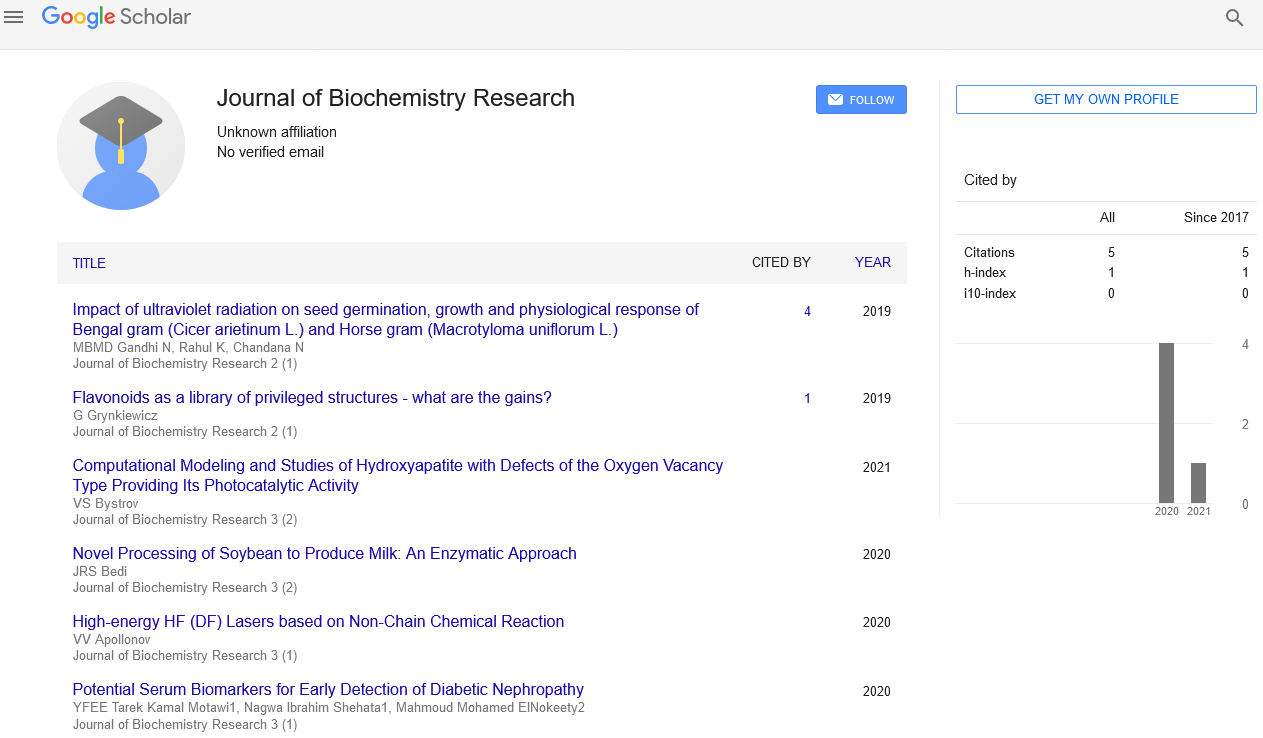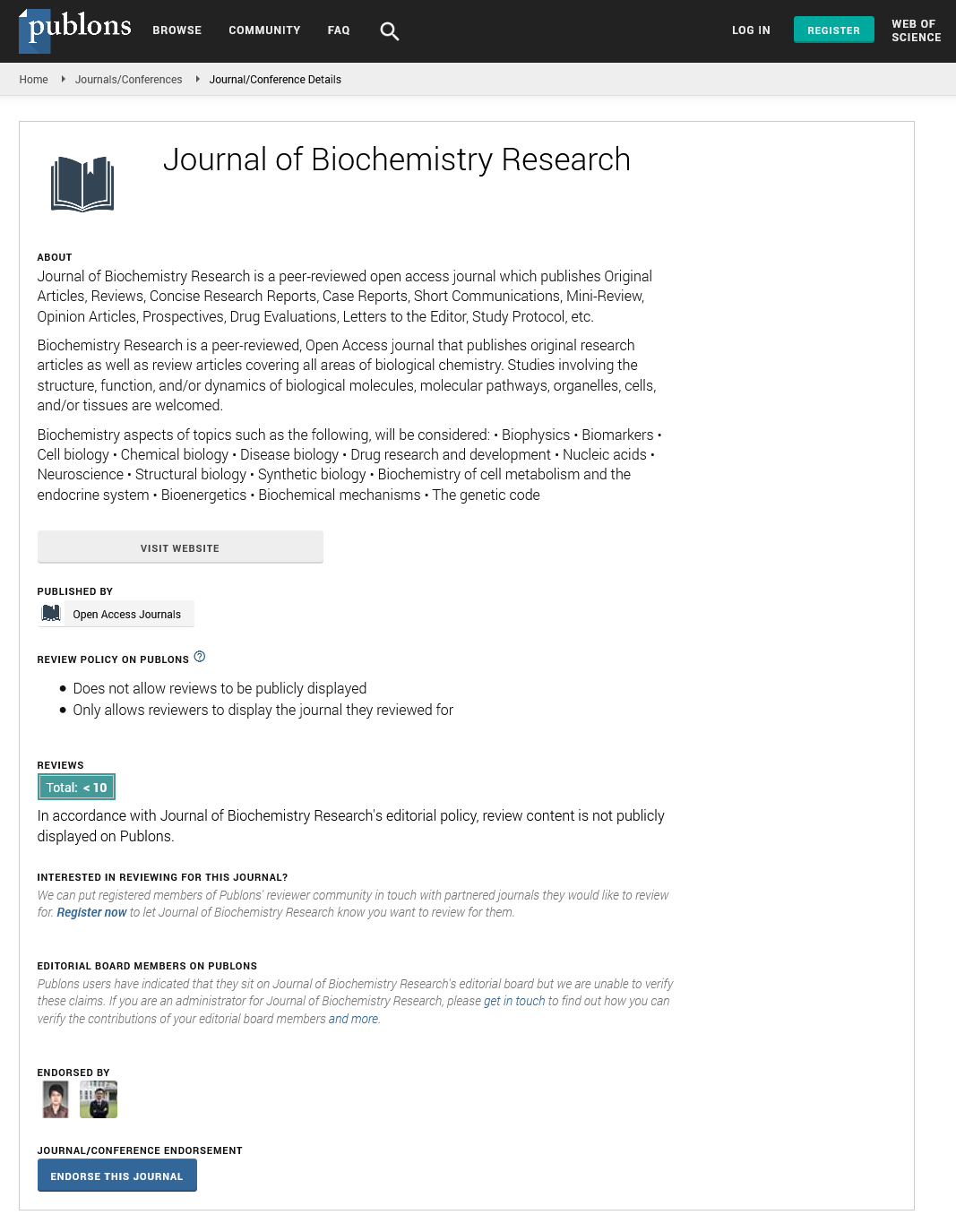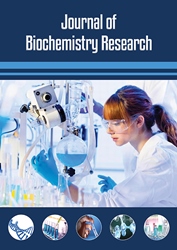Editorial - Journal of Biochemistry Research (2023) Volume 6, Issue 3
Enzyme Function and Drug Development: Unveiling the Path to Therapeutic Breakthroughs
Dr. Bing Shan*
College of Computer Science, Department of biochemistry, Bhutan University
College of Computer Science, Department of biochemistry, Bhutan University
E-mail: bings@gmail.com
Received: 02-06-2023, Manuscript No. oabr-23-101501; Editor assigned: 05-06-2023, Pre QC No. oabr-23- 101501; Reviewed: 19-06-2023, QC No. oabr-23-101501; Revised: 22-06- 2023, Manuscript No. oabr-23-101501 (R); Published: 29-06-2023; DOI: 10.37532/oabr.2023.6(3).51-54
Abstract
Enzymes are essential proteins that catalyze biochemical reactions in living organisms, playing a crucial role in various physiological processes. Understanding enzyme function is fundamental for elucidating the mechanisms underlying biological processes and designing effective therapeutic interventions. This abstract explores the significance of enzyme function in drug development and highlights the strategies employed to target enzymes for therapeutic purposes. The study emphasizes the importance of structural and mechanistic studies in uncovering enzyme function and explore the challenges and opportunities in developing enzyme-targeted drugs. Additionally, it discusses recent advances and emerging trends in enzyme-based drug discovery and the potential impact of these developments in the field of medicine.
Keywords
Enzymes • Enzyme function • Catalysis • Biochemical reactions • Drug development • Therapeutic interventions • Physiological Processes
Introduction
Enzymes play a vital role in maintaining the intricate biochemical processes within living organisms. These biomolecules catalyze a myriad of reactions, enabling the conversion of substrates into products with remarkable efficiency and specificity [1]. In recent years, there has been a growing interest in leveraging enzyme function to drive drug development and revolutionize the field of therapeutics [2]. This article explores the significance of enzymes in drug development, delves into their diverse functions, and highlights the potential they hold in paving the way for novel therapeutic breakthroughs [3]. Enzymes play a crucial role in various biological processes, serving as catalysts that accelerate chemical reactions within living organisms [4]. These remarkable proteins are essential for maintaining homeostasis and enabling numerous physiological functions [5]. Due to their central role in biological systems, enzymes have become key targets in drug development. Enzymes exhibit remarkable specificity and efficiency, enabling them to carry out complex biochemical transformations with remarkable precision [6]. They function by binding to specific molecules known as substrates, which undergo a series of chemical transformations facilitated by the enzyme’s active site [7]. This process often involves the breaking and formation of chemical bonds, resulting in the conversion of substrates into different products. The understanding of enzyme function is critical in drug development [8]. Many diseases arise from dysregulation or dysfunction of specific enzymes. Consequently, targeting these enzymes with drugs can help restore normal biological processes or disrupt harmful ones. The development of enzyme inhibitors, which selectively bind to and modulate the activity of specific enzymes, has proven to be an effective strategy in combating various diseases [9]. Drug development efforts often focus on identifying molecules that can selectively interact with a target enzyme, either by blocking its activity (enzyme inhibitors) or by enhancing its function (enzyme activators). This requires a thorough understanding of the enzyme’s structure, catalytic mechanism, and regulatory processes. With advancements in techniques such as X-ray crystallography, nuclear magnetic resonance (NMR) spectroscopy, and computational modeling, scientists have been able to elucidate the three-dimensional structures of enzymes and gain insights into their functional properties. Enzyme inhibitors can be designed to bind to the active site of an enzyme, preventing its interaction treat a wide range of disorders, including cancer, metabolic disorders, infectious diseases, and neurodegenerative conditions. The discovery and development of enzyme-targeted drugs are complex processes that involve various stages, including target identification; lead compound discovery, optimization, preclinical testing, and clinical trials. Rational drug design approaches, combined with high-throughput screening techniques and computational modeling, have accelerated the process of identifying potential drug candidates [10]. With substrates or altering its catalytic activity. Alternatively, inhibitors can target allosteric sites, distant from the active site, to modulate enzyme function. By selectively inhibiting or modulating key enzymes involved in disease pathways, it is possible to develop drugs that can effectively.
Understanding enzymes: Enzymes are protein molecules that act as biological catalysts, accelerating chemical reactions by lowering the activation energy required for a reaction to occur. They are characterized by their remarkable specificity, exhibiting the ability to interact with a particular substrate and convert it into a specific product. Enzymes achieve this specificity through their three-dimensional structure, which creates an active site perfectly shaped to accommodate the substrate. This lock-and-key mechanism ensures that only the appropriate substrate can bind and be acted upon by the enzyme.
Enzyme classes and functions: Enzymes are classified into several broad categories based on the type of reaction they catalyze. Some of the major enzyme classes include oxidoreductases, transferees, hydrolases, lyases, isomerases, and ligases. Each class performs a distinct function in the cell and contributes to vital physiological processes.
Oxidoreductases: These enzymes facilitate oxidation and reduction reactions, transferring electrons between molecules. They are involved in energy production, such as the electron transport chain in mitochondria, and detoxification processes within the body.
Transferases: Transferases catalyze the transfer of functional groups, such as a methyl or phosphate group, from one molecule to another. These enzymes play a critical role in cellular metabolism and signal transduction pathways.
Hydrolases: Hydrolases break down molecules through hydrolysis, a process that involves the addition of water. Examples include proteases, which hydrolyze proteins, and lipases, which break down lipids.
Lyases: Lyases cleave chemical bonds, resulting in the formation of double bonds or the addition of groups to double bonds. They are involved in diverse processes, including DNA repair, carbohydrate metabolism, and the production of certain neurotransmitters.
Isomerases: Isomerases catalyze the conversion of molecules from one isomer to another. They are crucial for maintaining the balance between different forms of molecules within the cell.
Ligases: Ligases facilitate the joining of two molecules, typically through the formation of a new chemical bond. They are involved in DNA replication, repair, and synthesis of essential biomolecules.
Enzymes in drug development: Enzymes have emerged as key targets for drug development due to their involvement in various diseases and their potential as therapeutic agents. Here are some ways in which enzymes contribute to the development of new drugs:
Targeted inhibition: Many diseases are characterized by the overactivity or dysregulation of specific enzymes. By designing small molecules that selectively inhibit these enzymes, researchers can modulate their function and potentially treat the associated disease. For example, enzyme inhibitors have revolutionized the field of HIV/ AIDS treatment by targeting viral proteases and reverse transcriptases.
Enzyme replacement therapy: In certain genetic disorders, patients lack specific enzymes required for proper metabolism. Enzyme replacement therapy involves administering the missing enzyme to restore normal function. This approach has been successful in treating diseases like Gaucher’s disease and Fabry disease.
Prodrug activation: Prodrugs are inactive compounds that are converted into their active form by enzymatic reactions.
Enzymes play a crucial role in drug development by facilitating various biochemical reactions involved in drug metabolism, target engagement, and therapeutic efficacy. Here are some types of enzymes commonly involved in drug development.
Cytochrome P450 (CYP) enzymes: CYP enzymes are a superfamily of enzymes responsible for metabolizing a wide range of drugs. They play a significant role in drug metabolism, particularly in Phase I reactions such as oxidation, reduction, and hydrolysis. Understanding the specific CYP enzymes involved in drug metabolism is essential for predicting drug-drug interactions and optimizing dosing regimens.
Kinases: Kinases are enzymes that catalyze the transfer of a phosphate group from ATP to specific substrates, such as proteins. They are important therapeutic targets in drug development, especially in the field of oncology. Inhibiting specific kinases can modulate signaling pathways and disrupt aberrant cell proliferation associated with cancer.
Proteases: Proteases are enzymes involved in the breakdown of proteins by cleaving peptide bonds. They have diverse roles in cellular processes, including protein degradation, post-translational modifications, and signaling pathways. Proteases are targeted in drug development to inhibit their activity or selectively modulate their function, particularly in diseases where protease dysregulation is implicated, such as HIV/AIDS and inflammatory conditions.
Polymerases: Polymerases are enzymes responsible for catalyzing DNA and RNA synthesis during replication and transcription. Inhibiting specific polymerases can disrupt viral replication in antiviral drug development or selectively target cancer cells with mutations in DNA repair pathways.
Hydrolases: Hydrolases are enzymes that catalyze the hydrolysis of various chemical bonds by adding water molecules. They are involved in drug metabolism and the breakdown of xenobiotics in the body. Examples include esterases, amidases, and glucuronidases. Understanding the activity of hydrolases can be crucial for predicting drug clearance and designing prodrugs.
Oxidoreductases: Oxidoreductases are enzymes involved in redox reactions, facilitating the transfer of electrons between molecules. They play a critical role in drug metabolism, particularly in Phase I reactions. Examples include alcohol dehydrogenases, aldehyde oxidases, and flavincontaining monooxygenases (FMOs).
Transferases: Transferases are enzymes that catalyze the transfer of functional groups, such as methyl, acetyl, or phosphate groups, from one molecule to another. They are involved in various cellular processes and can be targeted for therapeutic interventions. Examples include methyltransferases and kinase transferases.
Dehydrogenases: Dehydrogenases are enzymes that catalyze the removal of hydrogen atoms from substrates. They play a role in drug metabolism, particularly in Phase I reactions. Examples include aldehyde dehydrogenases and alcohol dehydrogenases.
Conclusion
The study of enzyme function plays a crucial role in drug development. Enzymes are biological catalysts that facilitate essential biochemical reactions in living organisms. They are involved in numerous cellular processes, including metabolism, signaling, and DNA replication. By understanding the structure, mechanism, and regulation of enzymes, scientists can design targeted drugs that modulate their activity to treat various diseases. Enzymes are attractive targets for drug development due to their specificity and catalytic efficiency. Researchers aim to either enhance or inhibit enzyme activity to achieve therapeutic effects. In the case of enzyme deficiencies, such as in metabolic disorders, enzyme replacement therapies can be developed to restore normal function. On the other hand, inhibiting enzymes that are overactive or mutated can help combat diseases like cancer, inflammation, and infections. Advancements in technology, such as high-throughput screening and structural biology techniques, have accelerated the discovery and optimization of enzyme-targeted drugs. These approaches enable the identification of small molecules or biologics that bind to specific enzyme targets and modulate their activity. Rational drug design techniques, guided by computational modeling and structure-based drug discovery, have also proven effective in developing enzyme-targeted therapeutics. Enzyme function studies have led to the development of numerous successful drugs that have revolutionized medicine. Examples include statins for lowering cholesterol levels, protease inhibitors for treating HIV/AIDS, and kinase inhibitors for cancer therapy. These drugs have improved patient outcomes and significantly impacted public health. However, challenges remain in drug development targeting enzymes. One major challenge is achieving sufficient selectivity, as many enzymes share structural similarities, making it difficult to design drugs that only target the intended enzyme without affecting others. Additionally, drug resistance can emerge due to mutations in the targeted enzyme or alternative biochemical pathways, requiring ongoing research and development efforts. In conclusion, a deep understanding of enzyme function is fundamental to drug development. Advances in enzyme research have paved the way for the discovery of effective and targeted therapeutics. Continued exploration of enzyme biology, coupled with innovative drug discovery strategies, holds great promise for the development of novel drugs to combat a wide range of diseases and improve human health.
References
- Taylor D. The Pharmaceutical Industry and the Future of Drug Development Issues in Environmental Science and Technology. R. Soc Chem.1-33 (2015).
- DiMasi JA, Grabowski HG, Hansen RW. Innovation in the pharmaceutical industry: New estimates of R&D costs. J Health Econ. 47,20-33 (2016).
- Kessler DA, Feiden KL. Faster evaluation of vital drugs. Sci Am. 272,48-54 (1995).
- Sertkaya A, Wong HH, Jessup A et al. Key cost drivers of pharmaceutical clinical trials in the United States. Clinical Trials. 13, 117-26 (2016).
- Madorran E, Stožer A, Bevc S et al. In vitro toxicity model: Upgrades to bridge the gap between preclinical and clinical research. Bosn J Basic Med Sci. 20,157-168 (2020).
- Wang Y. Extracting knowledge from failed development programmes. Pharmaceut Med. 26, 91-96 (2012).
- Van Norman GA. Phase II Trials in Drug Development and Adaptive Trial Design. JACC Transl. Sci. 4, 428-437 (2019).
- Sertkaya A, Wong HH, Jessup A et al. Key cost drivers of pharmaceutical clinical trials in the United States. Clinical Trials. 13, 117-26(2016).
- Fogel DB. Factors associated with clinical trials that fail and opportunities for improving the likelihood of success: A review. Contemp Clin Trials Commun.11, 156-164 (2018).
- Prasad V, Mailankody S .Research and Development Spending to Bring a Single Cancer Drug to Market and Revenues After Approval. JAMA Intern Med. 177, 1569-1575(2017).
Indexed at, Google Scholar, Crossref
Indexed at, Google Scholar, Crossref
Indexed at, Google Scholar, Crossref
Indexed at, Google Scholar, Crossref
Indexed at, Google Scholar, Crossref
Indexed at, Google Scholar, Crossref
Indexed at, Google Scholar, Crossref
Indexed at, Google Scholar, Crossref
Indexed at, Google Scholar, Crossref


